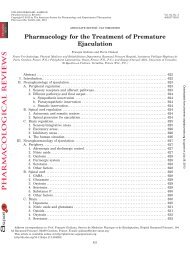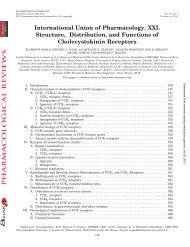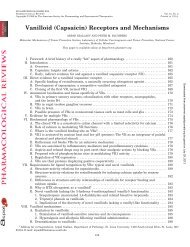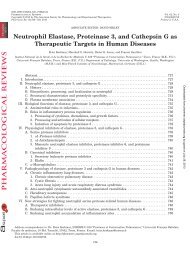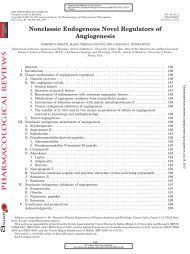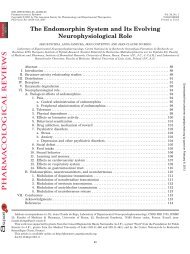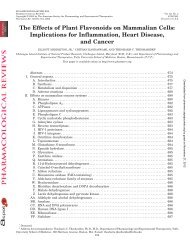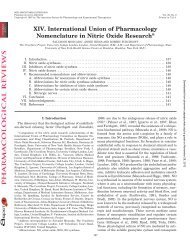Opioids, Reward and Addiction: An Encounter of Biology ...
Opioids, Reward and Addiction: An Encounter of Biology ...
Opioids, Reward and Addiction: An Encounter of Biology ...
You also want an ePaper? Increase the reach of your titles
YUMPU automatically turns print PDFs into web optimized ePapers that Google loves.
[()-4-[(-R*)--((2S*,5R*)-4-allyl-2,5-dimethyl-1piperazinyl)-3-methoxybenzyl]-N,N-diethylbenzamide]<br />
could induce conditioned place preference, which could<br />
be prevented by pretreatment with naltrindole (Longoni<br />
et al., 1998). In addition, morphine-induced place preference,<br />
which could not be blocked with the antagonist<br />
ICI 174,864 (Shippenberg et al., 1987) was shown to be<br />
abolished by the nonspecific antagonist naltrindole as<br />
well as by the receptor subtype antagonists BNTX ( 1)<br />
<strong>and</strong> naltriben ( 2) (Suzuki et al., 1994b; Kamei et al.,<br />
1997, but see Piepponen et al., 1997). In addition, the<br />
capacity <strong>of</strong> morphine to elicit conditioned place preference<br />
was found to be pr<strong>of</strong>oundly reduced in mice pretreated<br />
i.c.v. with antisense oligodeoxynucleotide to <br />
receptor mRNA (Suzuki et al., 1997a). Recently, it was<br />
also shown that both 1 <strong>and</strong> 2 receptor subtypes are<br />
involved in opioid place-conditioning, since both the 1<br />
agonist DPDPE <strong>and</strong> the 2 agonist [D-Ala 2 ]-deltorphin II<br />
induced place preference, both <strong>of</strong> which could be inhibited<br />
by specific antagonists (BNTX <strong>and</strong> naltriben, respectively)<br />
(Suzuki et al., 1996c, 1997c). Treatment with<br />
the nonpeptide agonist TAN-67 did not induce place<br />
preference but enhanced the ability <strong>of</strong> morphine to induce<br />
conditioned place preference. This effect <strong>of</strong> TAN-67<br />
could be antagonized with naltrindole, a nonselective <br />
antagonist as well as BNTX <strong>and</strong> naltriben, implicating<br />
both receptor subtypes ( 1 <strong>and</strong> 2) in this effect (Suzuki<br />
et al., 1996b; Kamei et al., 1997). Similar to receptors,<br />
uncoupling <strong>of</strong> receptors from G proteins with pertussis<br />
toxin, administered i.c.v., inhibited the development <strong>of</strong><br />
DPDPE-induced place preference (Suzuki et al., 1991).<br />
Stimulation <strong>of</strong> -opioid receptors induces place aversion.<br />
Systemic <strong>and</strong> i.c.v. injections <strong>of</strong> the -opioid agonists<br />
U50,488H, U69,593, <strong>and</strong> E-2078 <strong>and</strong> the opioid<br />
agonist-antagonist bremazocine induced aversion<br />
(Iwamoto, 1985; Mucha <strong>and</strong> Herz, 1985; Mucha et al.,<br />
1985; Shippenberg <strong>and</strong> Herz, 1987, 1988, 1991; Bals-<br />
Kubik et al., 1989; Funada et al., 1993; Shippenberg et<br />
al., 1993). In addition, morphine-induced preference is<br />
abolished by the agonists U50,488H <strong>and</strong> E-2078 (Funada<br />
et al., 1993; Bolanos et al., 1996). Intracerebroventricular<br />
dynorphin A(1–17) has been shown to induce<br />
naloxone-antagonizable place preference (Iwamoto,<br />
1988). This effect is, however, not necessarily mediated<br />
through receptors, since dynorphin A(1–17) has affinity<br />
for receptors as well. In addition, metabolization <strong>of</strong><br />
this peptide could yield a product with agonist activity at<br />
receptors (Höllt, 1986).<br />
There seems to be general agreement that stimulation<br />
<strong>of</strong> -opioid receptors induces conditioned place preference,<br />
whereas blockade <strong>of</strong> receptors induces place<br />
aversion. Stimulation <strong>of</strong> receptors induces conditioned<br />
place aversion, but blockade <strong>of</strong> receptors does not seem<br />
to induce significant place-conditioning. With regard to<br />
the involvement <strong>of</strong> receptors, stimulation <strong>of</strong> receptors<br />
with specific lig<strong>and</strong>s induces place preference, whereas<br />
blockade <strong>of</strong> receptor has no major effects on place-<br />
OPIOIDS, REWARD AND ADDICTION 367<br />
conditioning. However, the role <strong>of</strong> receptors in the<br />
place preference induced by morphine is not clear.<br />
2. Sites <strong>of</strong> Action. Studies into possible sites <strong>of</strong> action<br />
for opioids to induce place-conditioning have found two<br />
main areas: the NAC <strong>and</strong> VTA. With respect to the<br />
latter, injections <strong>of</strong> morphine, an enkephalin analog, <strong>and</strong><br />
DAMGO into the VTA have been shown to cause place<br />
preference (Phillips <strong>and</strong> LePiane, 1980, 1982; Phillips et<br />
al., 1983; Bozarth, 1987b; Bals-Kubik et al., 1993; Olmstead<br />
<strong>and</strong> Franklin, 1997b). Injections <strong>of</strong> morphine in<br />
sites adjacent to the VTA were without effect (Phillips<br />
<strong>and</strong> LePiane, 1980; Bozarth, 1987b; Olmstead <strong>and</strong><br />
Franklin, 1997b). The place preferences induced by intra-VTA-administered<br />
morphine or [D-Ala 2 ]-metenkephalin<br />
could be abolished by systemic pretreatment<br />
with naloxone (Phillips <strong>and</strong> LePiane, 1980, 1982) while<br />
preference induced by systemic morphine could be<br />
blocked by intra-VTA injections <strong>of</strong> naloxone methiodide<br />
(Olmstead <strong>and</strong> Franklin, 1997b). Intra-VTA injections <strong>of</strong><br />
the -opioid antagonist CTOP or naloxone induced place<br />
aversion, which were inhibited by 6-hydroxydopamine<br />
(6-OHDA)-induced lesions <strong>of</strong> the NAC (Shippenberg <strong>and</strong><br />
Bals-Kubik, 1995). The main effect <strong>of</strong> receptor stimulation<br />
in the VTA seems to be inhibition <strong>of</strong> -aminobutyric<br />
acid release (Johnson <strong>and</strong> North, 1992; Klitenick et<br />
al., 1992). In this respect, it is worth noting that the<br />
place preference induced by peripheral administration<br />
<strong>of</strong> morphine could be prevented with intra-VTA infusion<br />
<strong>of</strong> the -aminobutyric acid type B agonist bacl<strong>of</strong>en (Tsuji<br />
et al., 1996). Infusion <strong>of</strong> agonists (U50,488H, E-2078)<br />
into the VTA induced place aversion as well (Bals-Kubik<br />
et al., 1993).<br />
Morphine administered into the NAC was shown to<br />
result in place preference (Van der Kooy et al., 1982), but<br />
negative results with morphine or DAMGO administered<br />
into the NAC have also been published (Bals-<br />
Kubik et al., 1993; Olmstead <strong>and</strong> Franklin, 1997b; Schildein<br />
et al., 1998). Electrolytic as well as extensive<br />
NMDA- or kainic acid-induced lesions <strong>of</strong> the NAC have<br />
been shown to inhibit the development <strong>of</strong> morphineinduced<br />
place preference (Kelsey et al., 1989; Olmstead<br />
<strong>and</strong> Franklin, 1996). Similar to the VTA, administration<br />
<strong>of</strong> the antagonist CTOP or naloxone as well as the <br />
agonists U50,488H <strong>and</strong> E-2078 into the NAC resulted in<br />
place aversions (Bals-Kubik et al., 1993; Shippenberg<br />
<strong>and</strong> Bals-Kubik, 1995). 6-OHDA-induced lesions <strong>of</strong> the<br />
NAC abolished the place preference induced by peripheral<br />
injections <strong>of</strong> morphine <strong>and</strong> the place aversions induced<br />
by U69,593 (Shippenberg et al., 1993, but see<br />
Olmstead <strong>and</strong> Franklin, 1997a) but not the aversions<br />
induced by intra-NAC-injected CTOP or naloxone (Shippenberg<br />
<strong>and</strong> Bals-Kubik, 1995).<br />
There are a number <strong>of</strong> other sites that have been<br />
proposed to mediate the place preference induced by<br />
morphine or enkephalin <strong>and</strong> place aversion induced by<br />
-opioid agonists, respectively, but the involvement <strong>of</strong><br />
these sites has not been thoroughly investigated. For



